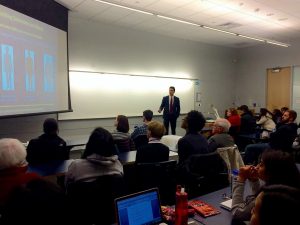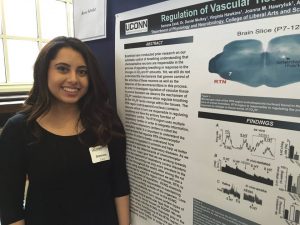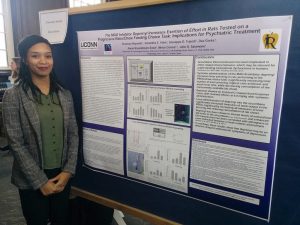 |
Arman Chowdhury, from West Hartford, CT is an undecided major. His interest in South Asian heritage linguistics is informed by his own background as a heritage speaker of Bengali. He graduated from Hall High School, where he was an arts writer for the school newspaper and a member of the chamber choir. At UConn, he is a member of Collegium Musicum (an early chamber music ensemble), Concert Choir, and Husky Hungama, a South Asian-Western fusion a capella group.
Project: Focus and Intonation in Heritage Hindi Speakers
Mentor: Prof. Diane Lillo-Martin, Dept. of Linguistics |
 |
Stella Kozloski, from New Fairfield, CT is an artist and student pursuing a BFA with a concentration in printmaking. In HS, she discovered a strong interest in print media after working as a graphic designer and editor for her school newspaper. Her work in cartooning has received recognition from the National Scholastic Art & Writing Awards. Stella is curious about “low-tech” forms of mass-media like the woodblock print, the unconscious processes that inform the development of an artwork, and art’s ever-changing role and purpose in a post-modern world. She enjoys gardening and hiking.
Project: Art as a Craft: The Interaction Between the Immaterial and the Material
Mentor: Prof. Ray DiCapua, Dept. of Art & Art History |
 |
Hollianne Lao, from Wallingford, CT is a political science major in the Special Program in Law. At Lyman Hall High School, she was two time captain of the Girls’ Swim and Dive Team, Student Council President, and a member of the National Honor Society. At UConn, Hollianne serves as Chief of Staff to the Office of the Speaker and as a residential Senator for the Undergraduate Student Government, and a Student Coordinator for the Honors Initiative for Prospective Students. You can also catch her articles in the Life section of The Daily Campus. This past year, she has worked with Professor Virginia Hettinger as a Bennett and SHARE Award Research Assistant. In her free time, she likes watching the women’s basketball team, spying Jonathan the Husky by Mirror Lake, and spending time with her friends.
Project: The Use of Social Media to Propel Women and Minority Political Candidates and the Engagement of their Voting Constituencies
Mentor: Prof. Virginia Hettinger, Dept. of Political Science |
 |
Sai Manasani, from South Windsor, CT is a Mathematics-Actuarial Science-Finance major who is interested in the ideas of big data analytics and public healthcare policies. She graduated from South Windsor HS where she was the Secretary-General of Model UN, Vice President of the National Honor Society, a member of the Science Olympiad Team, and a member of the Math Team. In her free time, she loves to play her viola and has attended numerous music festivals across New England. Currently, on campus, she is the Director of Alumni Relations of Gamma Iota Sigma, a passionate member of the Mock Wall Street Club, and a violist for the University Symphony Orchestra.
Project: A Cost-Benefit Analysis in the use of Technology in Life Insurance Underwriting
Mentor: Prof. Jeyaraj Vadiveloo, Dept. of Mathematics |
 |
Roshni Mehta is a STEM Scholar from Scarsdale, NY double majoring in Molecular and Cell Biology and French. She grew fascinated with research in high school, where she studied prevention and detection techniques for oral cancer and lung cancer, respectively. Throughout high school, she volunteered at local elementary schools and hospitals and played the flute for her high school’s wind ensemble. On campus, she is the current Vice President for the Undergraduate Organization for Molecular and Cell Biology, and she enjoys doing community service through the STEM Scholar community and the Pre-Medical Society. She loves traveling, painting, and reading.
Project: Who Let the DoGs Out? An Analysis of RNA Transcription Readthrough and Termination
Mentor: Prof. Leighton Core, Dept. of Molecular & Cell Biology |
 |
Amisha Paul, from Southington, CT is a STEM Scholar majoring in Physiology & Neurobiology and Economics with a minor in Global Health. Passionate about social entrepreneurship, she started a non-profit that aids in the development of rural areas in India through the development of sustainable development initiatives. Currently, Amisha is an active member of UConn’s Global Health Symposium Organizing Committee, encouraging campus-wide dialogue surrounding global health. She is also a member of and dancer on UConn Sanskriti, an organization dedicated to the preservation of Indian Classical Arts. Amisha hopes to combine her passions for medicine, public service, and business to increase access to affordable and quality healthcare all around the globe.
Project: Ventricular and Proximal Structure Configuration in Patients with Hydrocephalus
Mentor: Dr. Joanne Conover, Dept. of Physiology and Neurobiology |
 |
Pooja Prasad , from Westford, MA, is a Molecular and Cell Biology major and STEM Scholar in the Special Program in Medicine. She first forayed into research as a HS intern under Dr. Faherty at the MGH Mucosal Immunology and Biology Research Center, where she investigated the Shigella pathogen genome. In HS, she was a member of the Speech and Debate Team and co-founded a STEM advocacy club. She also sings Carnatic Classical Music, presenting a concert in 2017 with the support of a NH State Council on the Arts grant. On campus, she is a member of the CLAS Student Leadership Board and an undergraduate student researcher at Dr. Thanh Nguyen’s lab. Her interest in engineering-based medicine drew her to investigate tissue engineering with piezoelectric materials. In her free time, you can catch her running on campus or fangirling over all things Marvel.
Project: A Novel Biodegradable Piezoelectric Scaffold for Muscular Tissue Regeneration
Mentor: Prof. Thanh Nguyen, Dept. of Mechanical Engineering |
|
Xavier Rouleau, from West Hartford, CT, is a Linguistic/Philosophy major who plans to pursue a career in postsecondary education. He graduated from Hall High where he led a comedy improv troupe named The Answer and was heavily involved in theatre. In his free time, Xavier enjoys playing guitar and making others laugh. He began investigating American discourse surrounding sexual assault due to its underrepresentation in scientific research. He hopes to contribute to a discourse on how Americans can discuss sexual assault in a more constructive manner.
Project: Writing About Rape: Use of Passive Voice as an Expression of Perceived Responsibility of the Victim
Mentors: Prof. Marie Coppola, Dept. of Psychological Sciences and Prof. William Snyder, Dept. of Linguistics |
 |
Aditi Sirsikar, from Acton, MA, is a STEM Scholar majoring in Physiology and Neurobiology. She graduated from Acton-Boxborough HS where she served as the Captain of the varsity swim and dive team. Aditi’s first research experience was a summer internship at Brain Power LLC., a technology startup that develops neuroscience-based software for individuals on the autism spectrum. Through moving conversations and additional research, Aditi became interested in understanding how to improve mental health services for individuals with autism. She hopes to continue research in this field by pursuing a medical degree or through a PhD. On campus, Aditi is involved through Community Outreach and is the Marketing and Recruitment Coordinator for the Peer Allies through Honors program.
Project: Self and Informant Reports of Depression and Autism Questionnaires in Young Adults
Mentor: Prof. Inge-Marie Eigsti, Dept. of Psychological Sciences |
 |
Liam Smego, from Greenwich, CT, is a Mechanical Engineering major and English minor with aspirations to pursue a career in flight control systems. He graduated from Regis High School in Manhattan, and as Captain led the cross-country team to its first state championship meet in fifteen years. He also published poetry and fiction in the school literary journal and served as a mentor for middle school students preparing for high school admissions. At UConn, Liam is a member of the club running team, Alpha Lambda Delta National Honor Society, and the American Institute of Aeronautics and Astronautics (AIAA). Liam enjoys discovering music in a large range of genres, from indie rock to jazz to experimental folk.
Project: Implementing a Problem-Based Game to Promote Student Learning: Lunar Landing
Mentor: Prof. Scott Brown, Dept. of Educational Psychology
|
 |
Shreya Sreenivas, from Coppell, TX, is a STEM Scholar majoring in computer science and physiology and neurobiology. She graduated from West Windsor Plainsboro HS South in NJ, but spent most of her high school years at Coppell HS, where she was involved on the Solar Car Racing Team, robotics, and was captain of her swim and volleyball teams. Since coming to UConn, she has joined Dr. Fumiko Hoeft’s BrainLENS lab, where she is exploring developmental cognitive neuroscience research with the goal of maximizing children’s potential in the academic domain. On campus, Shreya is involved with UConn’s Genetic Engineering Team (iGEM), Kids and UConn Bridging Education, and the CLAS Leadership Board.
Project: Genetic Variability and Reading Abilities in Dyslexia
Mentor: Prof. Fumiko Hoeft, Dept. of Psychological Sciences
|















